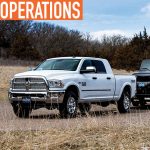From evolving emissions standards to the demand for more data-driven decision making, several key trends affect productivity, technician satisfaction, and costs in your work truck fleet. Understanding these industry trends can help you stay ahead of them, maximizing profits and minimizing losses.
1 REDUCING ENGINE IDLE
As more trucks that comply with the Environmental Protection Agency’s Tier 4 regulations are introduced into the market, it’s important to understand the new requirements and the effect they can have on maintenance and downtime.
These engines use a diesel particulate filter (DPF) to trap soot from engine exhaust gases. The DPF requires periodic cleaning through regeneration to safely capture and burn exhaust particulate material until the next regeneration cycle. How frequently DPF regeneration must happen depends on several factors, including how much time a work truck spends idling. The more time a truck engine idles—such as to power air compressors, pumps, hydraulic cranes, and other jobsite tools with a PTO-driven system—the more clogged the filter becomes and the more frequently it requires regeneration. Each regeneration cycle can result in up to an hour of truck downtime.
Excessive engine idling also consumes more fuel, shortens component life, and can affect warranty coverage. Idle hours count as engine hours, which measure how much an engine has run since it was manufactured. Warranties are measured in engine-run hours rather than miles traveled. As idle hours add up in engine hours, it can void the powertrain warranty faster than anticipated.
All-in-one power systems maintain the power capabilities of a traditional PTO system—including compressed air, electrical power, battery charging, and welding—all while the truck’s engine is turned off. These solutions help significantly reduce truck engine idling, which in turn lets fleets reduce fuel costs, prolong component life, and get the most out of the warranty.
2 USING TELEMATICS AND DATA-DRIVEN MAINTENANCE
With growing pressure to optimize fleet use, vehicles equipped with telematics are becoming the norm. Telematics provides data about a fleet’s operation that can help you get to the bottom of issues that may be costing time and money.
But telematics goes beyond just the work truck. Separate pieces of equipment and components on the truck—as well as other equipment on the jobsite—can all be integrated with telematics. This data can be used to determine maintenance, usage, and repair needs of a product. But not all systems are created equal. Be sure to look for equipment and tools that integrate into your telematics for a more complete picture of performance.
The result is better asset use through key metrics. Telematics is even making third-party maintenance and fleet management possible with vehicle leasing programs, allowing a company in New York to manage a fleet in California.
Want to know how many hours each truck in your fleet is idling every day? Done. Need to know how much fuel is used per shift and what vehicle or equipment is using the fuel? Check. Want to track when equipment on the truck needs servicing? Telematics can do that, too.
The ability to save even $10 per truck per day can deliver significant payback, especially for larger fleets that may have hundreds or even thousands of trucks to manage.
3 REDUCING TRUCK WEIGHT
Many fleets are looking for solutions to help reduce truck weight—from truck bodies made of aluminum or composite materials to using lighter equipment on certain trucks. Switching to an all-in-one power system allows technicians to carry fewer machines on their trucks without losing any capabilities.
A truck that weighs less can deliver benefits for safety and chassis life in addition to making it easier to find drivers.

ABOVE: Reducing the weight of a work truck can deliver benefits for safety and chassis life while making it easier to find drivers. EnPak® all-in-one solutions reduce weight and take up less space compared to carrying a separate air compressor and engine-driven welder/generator.
FEATURED IMAGE: Changing emissions standards are having a significant effect on the work truck industry. The EnPak® A30GBW power system from Miller Electric Mfg. LLC helps reduce truck engine idling, which can lower fuel costs, prolong component life, and extend warranty coverage.
For Class 1 to 6 trucks, drivers do not need a commercial driver’s license (CDL), which can make it much easier for fleets to find drivers. A truck must be below 26,000 lbs to qualify as a Class 6 truck. This makes the weight of every tool and component on a work truck critical, as companies aim to come in under that 26,000-lb threshold.
Overloading a truck can lead to shortened chassis life and increased fuel usage. Extra weight can also be the cause of additional unscheduled maintenance and downtime. Equipment that creates weight and space savings also allows technicians to carry more parts and tools, so they have everything they need to complete the job without having to run back to the shop for parts.
Truck weight can also affect braking and safe operation. Work trucks are highly engineered; carrying more weight than they are designed for can be a critical safety issue.
4 DEALING WITH LABOR NEEDS
Hiring and retaining qualified drivers and mechanics is a challenge for many truck fleets. It can increase downtime and costs, as you repeatedly must find and train new technicians.
This trend affects how trucks are specified and outfitted. Some fleets may spend extra money to get extended cabs or aluminum wheels for improved comfort or aesthetics. Others may choose tools that help simplify the job, such as equipment with remote panels that don’t require a technician to climb in and out of the truck to make adjustments. Anything that makes the operator’s job easier or results in a more organized truck is in demand.
Some fleets incentivize their highest performing mechanics or technicians by giving them the best trucks to use. However, the need to attract and retain mechanics by offering bigger, flashier trucks can be a challenge for fleets that don’t want to over-specify their trucks.
5 ADAPTING TO THE CHASSIS SHORTAGE
The supply of chassis and truck bodies from manufacturers continues to be tight in the work truck industry. Because the number of trucks produced isn’t enough to meet demand, fleets may face lead times of 40 weeks or more when ordering new chassis and truck bodies.
With the potential for a year-long wait for new truck orders, fleets must make their existing assets last longer. This might mean more frequent maintenance and repair or taking weight off of older trucks to prolong chassis and component life.
The truck shortage coupled with the challenge of finding qualified drivers is leading some fleets to look at asset use. Fleets are considering smaller trucks with smaller equipment or even box vans as a response to the shortage.
Battery-driven tools such as impact wrenches and guns are also becoming more common. This helps fleets reduce the size of their air compressors, which in turn might allow them to use smaller trucks.
INDUSTRY CHALLENGES
These key industry challenges are likely impacting productivity, driver retention, and the bottom line in your work truck fleet. Staying ahead of these challenges and keeping your trucks running is all about getting the right people and the right equipment for the job.
ABOUT THE AUTHOR
Matt Sherrick is the product manager of the Power Systems Division at Miller Electric Mfg. LLC. Find out more, visit www.millerwelds.com.




